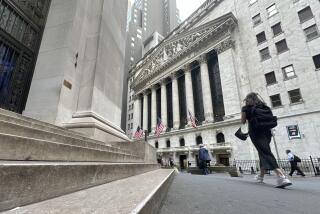‘87-Style Crash Unlikely; Fund Investors Hold Key
- Share via
Can it happen again?
With the Dow Jones industrial average off a stunning 161 points on Monday--and now down 7.4% from its May 22 peak--some analysts are beginning to wonder whether the market is being set up for a 1987-magnitude crash.
There are similarities between now and late-summer 1987, market experts concede: Interest rates have been rising this year, as they were in 1987. And stock prices have been selling at very high levels, historically, relative to underlying corporate profits, as they were in 1987.
Those two factors helped precipitate a market slide that culminated with a harrowing 508-point, 22.6% plunge in the Dow Jones average on Oct. 19, 1987.
But that massive one-day decline was fueled in large part by computerized selling orchestrated by institutional investors, such as pension funds.
Since then, that particular style of computerized selling, or “program” trading, has been limited by the New York Stock Exchange.
Indeed, it is impossible today for the market to cascade in an uninterrupted decline on a scale with the 1987 plunge, because the NYSE long ago put in place trading curbs that would halt such a slide, at least temporarily.
If the Dow falls 250 points in one day, the NYSE would suspend trading for one hour. Once trading resumes, if the market falls further, so that the Dow is off 400 points in all, trading would again be suspended, this time for two hours.
Other U.S. stock markets, such as the Nasdaq market, would suspend trading along with the NYSE.
The idea behind the trading halts would be to give investors breathing room, in theory allowing a more rational appraisal of the market. But they have never been tested.
Even if the market can’t fall as rapidly as it did in October 1987, analysts concede that a slow-motion crash--basically a bear market--is possible if investors’ attitude toward stocks were to grow excessively pessimistic. Such bear markets could last for years, and result in overall declines of as much as 30% to 40% or even more.
*
The driving force behind a slow-motion crash this time, some experts fear, could be a huge liquidation of stock mutual fund shares by small investors.
No one knows how many stock fund investors there are, but the number is clearly in the tens of millions, and there are about 70 million separate stock fund accounts (individuals often have multiple accounts).
Should the investors who own the funds begin to pull their money out in large numbers, fund managers could be forced to sell their underlying stocks, exacerbating an already steep price slide and possibly producing over time the wrenching double-digit percentage declines that define a full-scale stock market crash.
Over the past several years, as the bull market has pushed stock prices ever higher, mutual fund investors have poured record sums into stock funds, tripling fund assets since 1992, to $1.5 trillion today.
That is still less stock than is in pension funds, where equity holdings are roughly $3 trillion. But mutual funds’ power over the market has unquestionably grown dramatically in the 1990s.
So far in the current market decline, most fund companies say individuals have sold little.
“We haven’t received any large influx of calls [to indicate a sell-off] and we wouldn’t expect it,” says Holly Gibson, spokeswoman for Franklin/Templeton Funds in San Mateo, Calif.
In fact, the Investment Company Institute, the funds’ chief trade group, has studied how mutual fund investors have reacted to market pullbacks. Even in the throes of the 1987 market debacle, very few fund investors sold, the ICI says.
Fewer than 5% of the stock fund owners liquidated their shares in the two weeks following the 1987 crash, an ICI study showed.
Many experts say Wall Street continually underestimates individuals’ market savvy. Moreover, experts point out that many small investors own stock funds through 401(k) and other types of retirement accounts today, which by definition are supposed to be long-term accounts.
Thus, there is a strong sense that many or most fund investors will not be panicked out of the funds even in a bear market.
But fund analysts also concede that most of the investors in stock funds today weren’t invested in the 1987 market crash. In fact, most investors have entered the market since 1990, and thus have never experienced a bear market, nor even a 10% pullback in broad stock market indexes.
*
“Some studies indicate that mutual fund investors are more sophisticated and less likely to sell in a panic,” concedes Gary Schlossberg, markets economist with Wells Fargo Bank in San Francisco. “But how the mutual fund investor reacts to a sustained decline is anybody’s guess.”
Moreover, some analysts caution that the focus on mutual fund investors is myopic and that a slow-motion crash could be fueled by widespread selling by institutional investors who are under pressure from their clients to deliver strong short-term returns. Those institutions, such as corporate pension funds, often feel they don’t have the luxury of being able to ride out market dips, as many individuals can.
Times senior economics editor James Flanigan contributed to this analysis.
More to Read
Inside the business of entertainment
The Wide Shot brings you news, analysis and insights on everything from streaming wars to production — and what it all means for the future.
You may occasionally receive promotional content from the Los Angeles Times.










